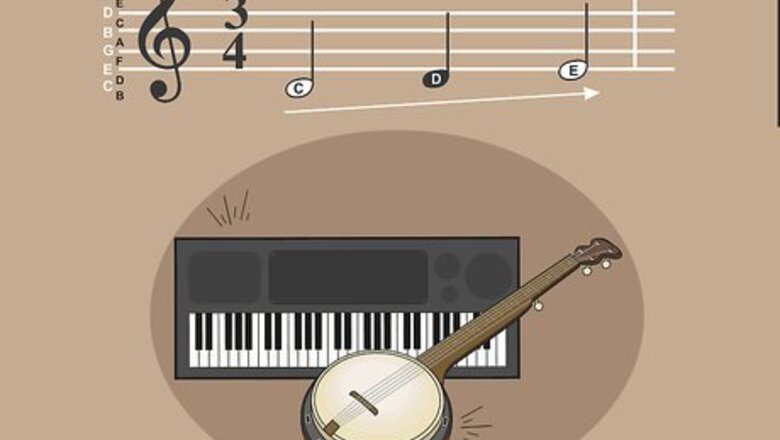
views
X
Research source
It may seem difficult at first, but you can transpose music without having to learn a lot of music theory.
Moving All the Notes

Identify the correct interval. To transpose music from C to E flat, you can either move it up a major sixth or down a minor third. A major sixth is 9 half-steps. A minor third is 3 half-steps. If you moved the key signature up a major sixth, you will need to move each note up 9 half-steps. If you moved the key signature down a minor third, you'll need to move each note down 3 half-steps. Once you've identified the correct interval, you can transpose the music without really knowing any further music theory. All you have to do is count the steps.

Get some blank staff paper. You can buy blank staff paper from any music store. You may also be able to download blank staff paper online for free and print off as many sheets as you need. Set your blank staff paper in front of you with the original music on one side and your blank staff paper on the other side. Use pencil rather than a pen, especially if this is your first time transposing music. Assume you'll make mistakes.
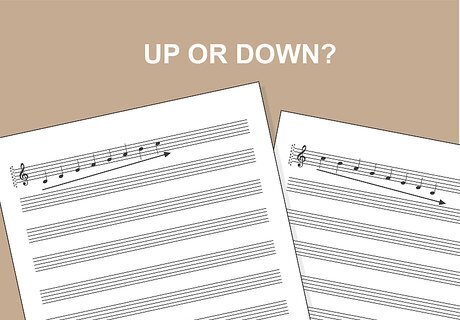
Determine whether to move the notes up or down. You have the choice of moving the notes up a major sixth or down a minor third to transpose the music correctly. Generally, you'll move the notes down if they would be too high for the instrument to play if you moved them up. For example, a sax can only play as high as an F6. If you have any notes higher than that, you would need to move the notes down rather than up. You don't necessarily need an extensive knowledge of written music to see this. If the transposed notes are falling far above the staff lines, they're likely too high. Test this before you do all the work of transposing several sheets of music, only to find a note that's too high. Scan the music for the highest notes, then move them up a major sixth. If they are too high for the instrument to play, you'll need to move the notes down a minor third.
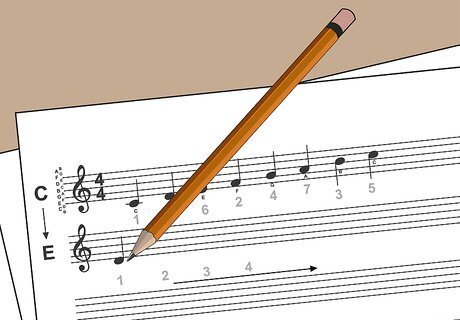
Move each of the notes the correct number of steps. To transpose the piece of music, work note by note, counting the correct number of steps and marking the new note on your blank staff paper. If the original music has accidentals (sharps, flats, or naturals written into the music), ignore them for now. Simply transpose the note as though it wasn't an accidental. If you're moving the notes up a major sixth, count 5 lines or spaces from the location of the original note. That's where your transposed note will be. If you're moving the notes down a minor third, count 2 lines or spaces down from the location of the original note. That's the new location for your transposed note.
Writing the New Key Signature

Check the key signature of the original music. While you're transposing concert pitch music to play on an E-flat instrument, that doesn't necessarily mean that the music itself is in the key of C. When you moved the notes before, you were simply moving them the correct interval, ignoring the key signature. Now you need to move the key signature as well. The key signature is the group of sharps or flats noted on the sheet music next to the treble clef. Each key signature has a different grouping of sharps or flats.
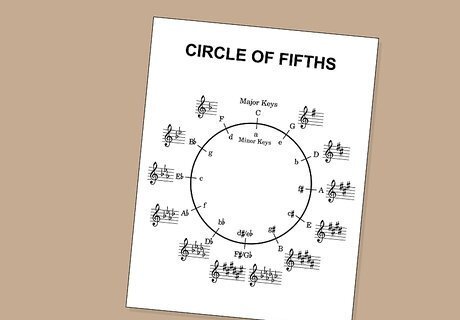
Use the circle of fifths to find your new key signature. The circle of fifths is a tool that allows you to find the right key signature for your transposed music. Using the circle of fifths, you can determine how many sharps and flats are in your new key signature. If you don't already have a copy of the circle of fifths, you can download an image for free online. Simply do a search for "circle of fifths" and pick one that you like. If you moved the notes up a major sixth, start at the original key and move 9 half-steps counterclockwise. That is your new key. If you moved the notes down a minor third, start at the original key and move clockwise 3 half-steps. That is your new key.

Mark your new key signature on your staff paper. Check your new key signature on your circle of fifths to figure out which notes should be sharp or flat. Mark these on your staff paper next to the treble clef. The circle of fifths will tell you which sharps and flats you need. For example, suppose your concert pitch music was in G. You transposed the music to E flat by moving the notes down a minor third. From the circle of fifths you can see that your new key signature is E major. E major has 4 sharps: F, C, G, and D. To work out which notes should be sharp or flat, you can use a mnemonic device. For sharps (the keys you find moving clockwise), remember the phrase Father Charles Goes Down And Ends Battle. The first letter of each word corresponds to a note. So if E major has 4 sharps, the notes that are sharp are the notes that correspond to the first 4 words in your mnemonic device. For flats (the keys you find moving counterclockwise), you can read the same mnemonic backwards: Battle Ends And Down Goes Charles Father.
Fixing Any Accidentals

Scan the original music for accidentals. Once you've successfully moved all the notes, you still have to put back in any accidentals so the song will sound right when you play it on the transposing instrument. Find the accidentals – the notes that differ from the key signature – and note them on your transposed music. You likely moved the note to the position it would have been in if it weren't an accidental. Now your job is to adjust it so that it matches the accidental in the original music.
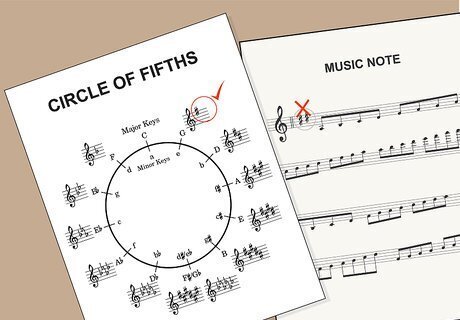
Determine the change made in the original key signature. Figure out what the accidental would have been if it weren't an accidental. Then count the half-steps it was raised or lowered to turn it into the accidental. For example, suppose your original music is in E flat major, and you have an accidental B natural. The note in the key is B flat, which means the accidental was raised a half a step.

Lower or raise the note to accommodate your new key signature. The interval between the note in the key and the accidental note for your transposed music must match the interval in the original music. Accordingly, if an accidental was raised a half-step, it should be raised a half-step in your transposed music as well. To continue the previous example, suppose you transposed that music down to the key of D major. The B was transposed to an A natural. To transpose the accidental, you would need to raise the A natural a half-step up to an A sharp.

Play the resulting phrase to make sure it sounds right. Either on a piano or on the transposing instrument itself, play the phrase with the adjusted accidental. Compare it to the original. The phrase should sound the same, just in a different key. If the accidental doesn't sound correct, go back to the original music and figure out where you went wrong. With a little practice, transposing accidentals will become second nature.


















Comments
0 comment